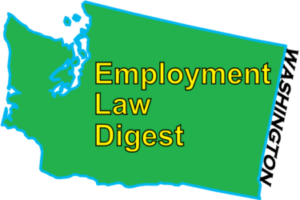This is a case summary of Lewis v. Lockheed Shipbuilding and Const. Co., 36 Wn.App. 607, 676 P.2d 545 (Wash.App. Div. 1 1984). “Simon Lewis appeal[ed] from the dismissal of his employment discrimination action against Lockheed Shipbuilding, alleging that the trial court applied an erroneous statute of limitations. [The Court of Appeals] … agree[d] and reverse[d] the order of dismissal.” Id. at 608. The subjects addressed herein include the following:
» STATUTE OF LIMITATIONS
» WASHINGTON LAW AGAINST DISCRIMINATION (WLAD)
(NOTE: this article does not address the additional issue concerning the continuing-violations doctrine.)
IMPORTANT: This article is for informational purposes only and is based upon my point of view. This is not a resource for the actual and complete appellate court opinion. Due to the rapidly changing nature of the law, we make no warranty or guarantee concerning the accuracy or reliability of the content in this article. No content on this site, regardless of date, should ever be used as a substitute for direct legal advice from your attorney. Please review our Disclaimer|Terms of Use|Privacy Policy before proceeding.

case summarY – 7 PRIMARY Facts:
[1] Lewis, a black male, was hired on October 12, 1977, by Lockheed Shipbuilding and Construction Company to work on a cable crew.
[2] It appears that Lewis suffered from hypertension, and that his doctor recommended that he be placed on light duty. [(Footnote omitted)].
[3] The collective bargaining agreement provided that an employee would be regarded as having voluntarily terminated his employment following three unexplained absences.
[4] Because Lewis failed to report to work for three consecutive workdays or more without explanation, Lockheed advised Lewis’ collective bargaining representative on May 4, 1978 that Lewis would not be rehired.
[5] It also appears that Lewis made several unsuccessful attempts to regain employment at Lockheed, but was turned down because he was placed in a “no re-hire” category.
[6] On March 6, 1981, Lewis sued Lockheed, alleging that his dismissal was the result of illegal discrimination under Washington law based on his disability and/or race.
[7] The trial court, however, granted Lockheed’s motion to dismiss on the ground that Lewis’ claim was barred by the 2-year statute of limitations, RCW 4.16.130.
Lewis v. Lockheed Shipbuilding and Const. Co., 36 Wn.App. 607, 608-09, 676 P.2d 545 (Wash.App. Div. 1 1984) (footnote omitted) (paragraph formatting and hyperlink to external website added).
ISSUE #1: Under the Washington Law Against Discrimination (RCW 49.60), do courts apply a 3-year statute of limitations to actions pursuant to RCW 4.16.080(2)?

[1-1] THE WASHINGTON LAW AGAINST DISCRIMINATION (WLAD) DOES NOT HAVE ITS OWN STATUTE OF LIMITATIONS
“RCW 49.60, the Washington Law Against Discrimination, does not have its own statute of limitations.” Lewis v. Lockheed Shipbuilding and Const. Co., 36 Wn.App. 607, 609, 676 P.2d 545 (Wash.App. Div. 1 1984) (hyperlink to external website added).
[1-2] TWO-YEAR STATUTE OF LIMITATIONS (“CATCH-ALL STATUTE”) — RCW 4.16.130
“RCW 4.16.130 provides:
Actions for relief not otherwise provided for. An action for relief not herein[before] … provided for, shall be commenced within two years after the cause of action shall have accrued.
Lewis, 36 Wn.App. at 609, 676 P.2d 545 (hyperlink to external website added). This is also known as the “catch-all” statute. See id at 611.
[1-3] THREE-YEAR STATUTE OF LIMITATIONS — RCW 4.16.080(2)
“RCW 4.16.080 provides in relevant part:
Actions limited to three years. Within three years:
* * *
(2) An action for taking, detaining, or injuring personal property, including an action for the specific recovery thereof, or for any other injury to the person or rights of another not hereinafter enumerated;
Lewis, 36 Wn.App. at 609, 676 P.2d 545 (hyperlink to external website added).
[1-3a] Three-Year Statute of Limitations Applies to Invasions to Plaintiff’s Person or Property Rights
“RCW 4.16.080(2) applies only to certain direct invasions of a plaintiff’s person or property rights.” Lewis, 36 Wn.App. at 611 (citing Noble v. Martin, 191 Wash. 39, 46, 70 P.2d 1064 (1937); Peterick v. State, 22 Wash.App. 163, 168-69, 589 P.2d 250 (1977)) (hyperlink to external website added). Thus, “where the defendant directly invades a legally protected interest of the plaintiff, the 3-year statute applies.” Id. at 612.
[1-3b] The WLAD Liberal-Construction Mandate Supports 3-Year Statute of Limitations
“[S]upport for applying the 3-year statute is found in the Legislature’s directive that RCW 49.60 be liberally construed.” Lewis, 36 Wn.App. at 613 (citing Franklin County Sheriff’s Office v. Sellers, 97 Wash.2d 317, 334, 646 P.2d 113 (1982), cert. denied, — U.S. —-, 103 S.Ct. 730, 74 L.Ed.2d 954 (1983); Fahn v. Cowlitz County, 93 Wash.2d 368, 374, 610 P.2d 857 (1980)) (hyperlink to external website added).
[1-4] THE CASELAW (4 CASES)
In this case, the Court evaluated the following five cases to resolve the issue concerning statute of limitations:
[1-4a] Canon v. Miller
» “In Cannon [v. Miller, 22 Wash.2d 227, 155 P.2d 500, 157 A.L.R. 530 (1045)], the plaintiffs sought to recover unpaid overtime wages under the Fair Labor Standards Act (FLSA), 29 U.S.C.A. § 201, et seq. (West 1978).” Lewis, 36 Wn.App. at 609 (hyperlink to external website added).
» “Because the FLSA does not have its own statute of limitations, the statute of limitations of the state where the action was brought was applicable.” Id.
» “The plaintiffs contended that the 3-year contract statute of limitations applied, and the defendants relied on the 2-year catch-all statute.” Id. at 609-10.
» “The court recognized that although the FLSA in effect created an implied obligation in the employment contract to pay overtime wages, this liability was not truly contractual because it would not have existed but for the statute.” Id. at 610 (citing Cannon, 22 Wash.2d at 241, 155 P.2d 500).
» “Accordingly, the court held that FLSA actions were not governed by the contract statute of limitations, and instead applied the catch-all statute.” Id.
[1-4b] Luellen v. Aberdeen
» “In Luellen v. Aberdeen, 20 Wash.2d 594, 148 P.2d 849 (1944), the plaintiff sought reinstatement to the city police force.” Lewis, 36 Wn.App. at 612.
» “The court held that, because the plaintiff had acquired a property right to his civil service pension, the city invaded that right by firing him.” Id.
» “The court thus applied the 3-year statute, stating that it
was intended to cover injury to that kind of property that is intangible in its nature, especially when the injury consists of some direct, affirmative act which prevents another from securing, having, or enjoying some valuable right or privilege.”
Id. (citing Luellen, 20 Wash.2d at 604, 148 P.2d 849).
» Accordingly, Division One concluded: “[W]here the defendant directly invades a legally protected interest of the plaintiff, the 3-year statute applies.” Id.
[1-4C] State ex rel. Bond v. State
» “In State ex rel. Bond v. State, 59 Wash.2d 493, 368 P.2d 676 (1962), the plaintiff sought reinstatement to public employment pursuant to a statute granting veterans an employment preference.” Lewis, 36 Wn.App. at 610
» “He alleged that his claim fell within the 3-year statute as being an action upon ‘any other injury to the person or rights of another'”. Id. (citing Bond, 59 Wash.2d at 495, 368 P.2d 676. See RCW 4.16.080(2)) (internal quotation marks omitted) (hyperlink to external website added).
» “The defendant contended that the catch-all statute applied, because the plaintiff’s claim was founded upon a liability created by statute. The court flatly rejected this argument.” Id.
» “In the court’s view, cases such as Cannon held only that actions founded upon purely statutory liabilities do not fall within the 3-year contract statute of limitations–they did not hold that such actions necessarily fall within the catch-all statute.” Id. at 610-11 (citing Bond, 59 Wash.2d at 497-98, 368 P.2d 676) (footnotes omitted).
» The Court declared:
We reiterate that there is no such category as “an action on a liability created by a statute” in our limitation statutes. Such an action does not fall within the “catch-all” statute unless there is no other statute of limitations applicable thereto, i.e., it is “an action for relief not hereinbefore provided for.”
Id. at 611 (citing Bond, 59 Wash.2d at 498, 368 P.2d 676) (footnote omitted).
» “The court went on to hold that an action under the veteran’s preference statute fell within the predecessor of RCW 4.16.080(2) as being an action for any other injury to the person or rights of another not hereinafter enumerated.” Lewis, 36 Wn.App. at 611 (citing Bond, 59 Wash.2d at 500, 368 P.2d 676) (hyperlink to external website added).
[1-4D] Washington v. Northland Marine Co.
» “In Washington v. Northland Marine Co., 681 F.2d 582 (9th Cir.1982), the plaintiffs sued their union under the Labor Management Relations Act (LMRA), alleging that the union had not fulfilled its duty of representation.” Lewis, 36 Wn.App. at 612.
» “Because the LMRA has no statute of limitations, the court was forced to look to the appropriate Washington statute.” Id.
» “Following Luellen, the court rejected the catch-all statute and applied RCW 4.16.080(2), despite the fact that the plaintiffs’ right to union representation was clearly not a property right in the usual sense.” Lewis, 36 Wn.App. at 612 (hyperlink to external website added).

[1-5] LOCKHEED CONTENDS THAT THE 2-YEAR “CATCH-ALL” STATUTE OF LIMITATIONS APPLIES TO WLAD ACTIONS
In this case, Lockheed contends that the 2-year “catch-all” statute of limitations applies to WLAD actions pursuant to RCW 4.16.130; whereas Lewis argues that a 3-year statute of limitations applies under RCW 4.16.080(2). See Lewis, 36 Wn.App. at 609 (hyperlinks to external website added).
[1-5A] LOCKHEED’S ARGUMENT #1 — THE 2-YEAR STATUTE OF LIMITATIONS APPLIES to liabilities created by statute:
“Lockheed contends that the 2-year ‘catch-all’ statute of limitations, RCW 4.16.130, applies to actions brought under … [the Washington Law Against Discrimination].” Lewis, 36 Wn.App. at 609 (hyperlink to external website added). Accordingly, it asserts that “the 2-year catch-all statute of limitations applies to all causes of action that are founded upon liabilities created by statute.” Id. “Because Lewis would not have a claim but for the Washington Law Against Discrimination, his claim, Lockheed contends, falls within RCW 4.16.130.” Lewis, 36 Wn.App. at 609 (hyperlink to external website added). “Lockheed relies on Cannon v. Miller, 22 Wash.2d 227, 155 P.2d 500, 157 A.L.R. 530 (1945) to support this view.” Lewis, 36 Wn.App. at 609.
COURT’S ANALYSIS — LOCKHEED’S ARGUMENT #1
» There is no such category as an action on a liability created by a statute in our limitations statutes.
“Lockheed … relies on Cannon [v. Miller] for the proposition that all actions founded upon liabilities created by statute necessarily fall within the 2-year catch-all statute. We do not agree.” Lewis, 36 Wn.App. at 610. “We reiterate that there is no such category as ‘an action on a liability created by a statute’ in our limitation statutes. Such an action does not fall within the ‘catch-all’ statute unless there is no other statute of limitations applicable thereto, i.e., it is ‘an action for relief not hereinbefore provided for.'” Id. at 611. (citing State ex rel. Bond, 59 Wash.2d at 498, 368 P.2d 676).
[1-5B] LOCKHEED’S ARGUMENT #2 — THE WLAD DOES NOT PROTECT PROPERTY RIGHTS:
Moreover, “Lockheed, … argues that RCW 49.60 does not purport to confer or protect any property rights.” Lewis, 36 Wn.App. at 612-13 (hyperlink to external website added).
COURT’S ANALYSIS — LOCKHEED’S ARGUMENT #2
» This argument is disingenuous: The 3-year statute covers all direct invasions of property that are intangible in nature.
“[T]he issue here is if actions under RCW 49.60 fall within RCW 4.16.080(2). Only if they do not would the catch-all statute apply.” Lewis, 36 Wn.App. at 611 (hyperlinks to external website added). “RCW 4.16.080(2) applies only to certain direct invasions of a plaintiff’s person or property rights.” Lewis, 36 Wn.App. at 611 (internal citations omitted) (hyperlink to external website added). Accordingly, the Court found that Lockheed’s “argument is disingenuous. As [the case of] Luellen [v. Aberdeen] demonstrates, the 3-year statute covers all direct invasions of ‘property that is intangible in nature.'” Lewis, 36 Wn.App. at 613 (emphasis added).
EXAMPLE #1 (Washington v. Northland Marine): The Court offered Washington v. Northland Marine Co. for example: “In Washington v. Northland Marine Co., 681 F.2d 582 (9th Cir.1982), the plaintiffs sued their union under the Labor Management Relations Act (LMRA), alleging that the union had not fulfilled its duty of representation.” Lewis, 36 Wn.App. at 613. The Court determined:
Because the LMRA has no statute of limitations the court was forced to look to the appropriate Washington statute. Following Luellen, the court rejected the catch-all statute and applied RCW 4.16.080(2), despite the fact that the plaintiffs’ right to union representation was clearly not a property right in the usual sense.
Lewis, 36 Wn.App. at 613 (both hyperlink to external website and emphasis added).
EXAMPLE #2 (Luellen v. Aberdeen): The Court also determined that, in Luellen v. Aberdeen:
[T]he plaintiff sought reinstatement to the city police force. The court held that, because the plaintiff had acquired a property right to his civil service pension, the city invaded that right by firing him. The court thus applied the 3-year statute, stating that it was intended to cover injury to that kind of property that is intangible in its nature, especially when the injury consists of some direct, affirmative act which prevents another from securing, having, or enjoying some valuable right or privilege.
Lewis, 36 Wn.App. at 613 (citing Luellen, 20 Wn.2d at 604, 148 P.2d 849) (emphasis added).
[1-6] FURTHER SUPPORT FOR APPLYING THE 3-YEAR STATUTE OF LIMITATIONS IS FOUND IN WLAD:
Lastly, the Court determined: “Further support for applying the 3-year statute is found in the Legislature’s directive that RCW 49.60 be liberally construed.” Id. (citing Franklin County Sheriff’s Office v. Sellers, 97 Wash.2d 317, 334, 646 P.2d 113 (1982), cert. denied, — U.S. —-, 103 S.Ct. 730, 74 L.Ed.2d 954 (1983); Fahn v. Cowlitz County, 93 Wash.2d 368, 374, 610 P.2d 857 (1980)) (hyperlink to external website added).

[1-7] COURTS APPLY A 3-YEAR STATUTE OF LIMITATIONS TO WLAD ACTIONS PURSUANT TO RCW 4.16.080(2) — REVERSED & REMANDED:
Here, the Court found that under the Washington Law Against Discrimination (RCW 49.60), courts apply a 3-year statute of limitations to actions pursuant to RCW 4.16.080(2). See Lewis, 36 Wn.App. at 611-613 (hyperlinks to external website added). Moreover, the Court determined that, “even if the arguments favoring application of the 2 and 3-year statutes were otherwise fairly equal, applying the 3-year statute better supports the liberal policies underlying the Law Against Discrimination.” Id. at 613. Accordingly, Division One held: “The order dismissing the action is reversed and the case is remanded for trial.” Id. at 614.
NOTABLES & IMPLICATIONS:
FAILURE OF PUBLIC OFFICIALS TO PERFORM THEIR OFFICIAL DUTIES — northern grain & warehouse co. V. holst
The Court in this case also evaluated Northern Grain & Warehouse Co. v. Holst, to conclude:
Washington courts have consistently followed Northern Grain in holding that the 2-year catch-all statute applies to causes of action arising out of the failure of public officials to perform their official duties.
Lewis, 36 Wn.App. at 612 (citing Constable v. Duke, 144 Wash. 263, 266-67, 257 P. 637 (1927); Gates v. Rosen, 29 Wash.App. 936, 941, 631 P.2d 993 (1981), aff’d sub nom. Hall v. Niemer, 97 Wash.2d 574, 649 P.2d 98 (1982); Peterick v. State, supra, 22 Wash.App. at 169, 589 P.2d 250)).
The Court evaluated Northern Grain as follows:
• “In Northern Grain & Warehouse Co. v. Holst, [ ] the plaintiff was unable to retrieve grain stored at a warehouse upon presentation of a warehouse receipt.” Lewis, 36 Wn.App. at 611-12.
• “He then sued members of the public service commission for negligently issuing a license to the owner of the warehouse without obtaining a bond as required by state law.” Id. at 612.
• “The court reasoned that the 3-year statute of limitations for injuries to the ‘rights of another’ must be construed narrowly or it would incorporate all causes of action, completely nullifying the catch-all statute.” Id.
• “Accordingly, the court held that the plaintiff’s cause of action was not based upon an injury sufficiently direct to fall within the 3-year statute.” Id.
• “Rather, it was ‘indirectly based upon the failure of public officials to perform duties imposed by law.'” Id. (citing Northern Grain, 95 Wash. at 315, 163 P. 775).
• “Washington courts have consistently followed Northern Grain in holding that the 2-year catch-all statute applies to causes of action arising out of the failure of public officials to perform their official duties.” Lewis, 36 Wn.App. at 612 (citing Constable v. Duke, 144 Wash. 263, 266-67, 257 P. 637 (1927); Gates v. Rosen, 29 Wash.App. 936, 941, 631 P.2d 993 (1981), aff’d sub nom. Hall v. Niemer, 97 Wash.2d 574, 649 P.2d 98 (1982); Peterick v. State, supra, 22 Wash.App. at 169, 589 P.2d 250)).
LEARN MORE
If you would like to learn more, consider contacting an experienced employment discrimination attorney to discuss your case. This article is not offered as legal advice and will not establish an attorney-client relationship with Washington Employment Law Digest or the author of this article. By reading this article, you agree to our Disclaimer / Terms-of-Use / Privacy Policy.




